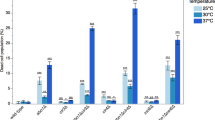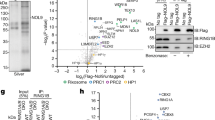Abstract
In eukaryotes, heterochromatin mediates diverse processes including gene silencing and regulation of long-range chromatin interactions1,2. The formation of heterochromatin involves a conserved array of histone modifications; in particular, methylation of histone H3 at Lys 9 (H3K9me) is essential for recruiting HP1/Swi6 proteins3. In fission yeast, the Clr4 methyltransferase is responsible for H3K9me across all heterochromatic domains4,5. However, the mechanism of Clr4 recruitment to these loci is poorly understood. We show that Clr4 associates with Cul4, a cullin family protein that serves as a scaffold for assembling ubiquitin ligases. Mutations in Cul4 result in defective localization of Clr4 and loss of silencing at heterochromatic loci. This is accompanied by a severe reduction in H3K9me and Swi6 levels, and accumulation of transcripts corresponding to naturally silenced repeat elements within heterochromatic domains. Moreover, heterochromatin defects in Cul4 mutants could not be rescued by expression of Cul4 protein lacking Nedd8 modification, which is essential for its ubiquitin ligase activity. Rik1, a protein related to DNA damage binding protein DDB1 and required for H3K9me4,6, also interacts with Cul4, the association of which might serve to target Clr4 to heterochromatic loci. These analyses uncover a role for Cul4-based protein ubiquitination in regulating H3K9me and heterochromatin formation.
This is a preview of subscription content, access via your institution
Access options
Subscribe to this journal
Receive 12 print issues and online access
$209.00 per year
only $17.42 per issue
Buy this article
- Purchase on Springer Link
- Instant access to full article PDF
Prices may be subject to local taxes which are calculated during checkout





Similar content being viewed by others
References
Hall, I. M. & Grewal, S. I. S. Structure and function of heterochromatin: implications for epigenetic gene silencing and genome organization. In RNAi: A Guide to Gene Silencing (ed. Hannon, G.) 205–232 (Cold Spring Harbor Laboratory Press, Cold Spring Harbor, 2003).
Jia, S., Yamada, T. & Grewal, S. I. S. Heterochromatin regulates cell type-specific long-range chromatin interactions essential for directed recombination. Cell 119, 469–480 (2004).
Jenuwein, T. & Allis, C. D. Translating the histone code. Science 293, 1074–1080 (2001).
Nakayama, J., Rice, J. C., Strahl, B. D., Allis, C. D. & Grewal, S. I. S. Role of histone H3 lysine 9 methylation in epigenetic control of heterochromatin assembly. Science 292, 110–113 (2001).
Cam, H. et al. Comprehensive analysis of heterochromatin- and RNAi-mediated epigenetic control of the fission yeast genome. Nature Genet. 37, 809–819 (2005).
Tuzon, C. T. et al. The fission yeast heterochromatin protein Rik1 is required for telomere clustering during meiosis. J. Cell Biol. 165, 759–765 (2004).
Bernard, P. et al. Requirement of heterochromatin for cohesion at centromeres. Science 294, 2539–2542 (2001).
Nonaka, N. et al. Recruitment of cohesin to heterochromatic regions by Swi6/HP1 in fission yeast. Nature Cell Biol. 4, 89–93 (2002).
Sims, R. J. 3rd, Nishioka, K. & Reinberg, D. Histone lysine methylation: a signature for chromatin function. Trends Genet. 19, 629–639 (2003).
Jia, S., Noma, K. & Grewal, S. I. S. RNAi-independent heterochromatin nucleation by the stress-activated ATF/CREB family proteins. Science 304, 1971–1976 (2004).
Matzke, M. A. & Birchler, J. A. RNAi-mediated pathways in the nucleus. Nature Rev. Genet. 6, 24–35 (2005).
Grewal, S. I. S. & Rice, J. C. Regulation of heterochromatin by histone methylation and small RNAs. Curr. Opin. Cell. Biol. 16, 230–238 (2004).
Chan, S. W., Henderson, I. R. & Jacobsen, S. E. Gardening the genome: DNA methylation in Arabidopsis thaliana. Nature Rev. Genet. 6, 351–360 (2005).
Noma, K. et al. RITS acts in cis to promote RNA interference-mediated transcriptional and post-transcriptional silencing. Nature Genet. 36, 1174–1180 (2004).
Petroski, M. D. & Deshaies, R. J. Function and regulation of cullin-RING ubiquitin ligases. Nature Rev. Mol. Cell Biol. 6, 9–20 (2005).
Sadaie, M., Iida, T., Urano, T. & Nakayama, J. A chromodomain protein, Chp1, is required for the establishment of heterochromatin in fission yeast. EMBO J. 23, 3825–3835 (2004).
Neuwald, A. F. & Poleksic, A. PSI-BLAST searches using hidden markov models of structural repeats: prediction of an unusual sliding DNA clamp and of β-propellers in UV-damaged DNA-binding protein. Nucl. Acids Res. 28, 3570–3580 (2000).
Hu, J., McCall, C. M., Ohta, T. & Xiong, Y. Targeted ubiquitination of CDT1 by the DDB1-CUL4A-ROC1 ligase in response to DNA damage. Nature Cell Biol. 6, 1003–1009 (2004).
Liu, C. et al. Cop9/signalosome subunits and Pcu4 regulate ribonucleotide reductase by both checkpoint-dependent and -independent mechanisms. Genes Dev. 17, 1130–1140 (2003).
Holmberg, C. et al. Ddb1 controls genome stability and meiosis in fission yeast. Genes Dev. 19, 853–862 (2005).
Sugiyama, T., Cam, H., Verdel, A., Moazed, D. & Grewal, S. I. S. RNA-dependent RNA polymerase is an essential component of a self-enforcing loop coupling heterochromatin assembly to siRNA production. Proc. Natl Acad. Sci. USA. 102, 152–157 (2005).
Niwa, O., Matsumoto, T. & Yanagida, M. Construction of mini-chromosome by deletion and its mitotic and meiotic behaviour in fission yeast. Mol. Gen. Genet. 203, 397–405 (1986).
Thon, G. & Klar, A. J. Directionality of fission yeast mating-type interconversion is controlled by the location of the donor loci. Genetics 134, 1045–1054 (1993).
Ivanova, A. V., Bonaduce, M. J., Ivanov, S. V. & Klar, A. J. The chromo and SET domains of the Clr4 protein are essential for silencing in fission yeast. Nature Genet. 19, 192–195 (1998).
Pan, Z. Q., Kentsis, A., Dias, D. C., Yamoah, K. & Wu, K. Nedd8 on cullin: building an expressway to protein destruction. Oncogene 23, 1985–1997 (2004).
Osaka, F. et al. Covalent modifier NEDD8 is essential for SCF ubiquitin-ligase in fission yeast. EMBO J. 19, 3475–3484 (2000).
Horn, P. J., Bastie, J. N. & Peterson, C. L. A Rik1-associated, cullin-dependent E3 ubiquitin ligase is essential for heterochromatin formation. Genes Dev. 19, 1705–1714 (2005).
Brand, M. et al. UV-damaged DNA-binding protein in the TFTC complex links DNA damage recognition to nucleosome acetylation. EMBO J. 20, 3187–3196 (2001).
Martinez, E. et al. Human STAGA complex is a chromatin-acetylating transcription coactivator that interacts with pre-mRNA splicing and DNA damage-binding factors in vivo. Mol. Cell. Biol. 21, 6782–6795 (2001).
Hall, I. M. et al. Establishment and maintenance of a heterochromatin domain. Science 297, 2232–2237 (2002).
Wang, H. et al. Role of histone H2A ubiquitination in Polycomb silencing. Nature 431, 873–878 (2004).
Sun, Z. W. & Allis, C. D. Ubiquitination of histone H2B regulates H3 methylation and gene silencing in yeast. Nature 418, 104–108 (2002).
Dover, J. et al. Methylation of histone H3 by COMPASS requires ubiquitination of histone H2B by Rad6. J. Biol. Chem. 277, 28368–28371 (2002).
Ng, H. H., Xu, R. M., Zhang, Y. & Struhl, K. Ubiquitination of histone H2B by Rad6 is required for efficient Dot1-mediated methylation of histone H3 lysine 79. J. Biol. Chem. 277, 34655–34657 (2002).
Briggs, S. D. et al. Gene silencing: trans-histone regulatory pathway in chromatin. Nature 418, 498 (2002).
Acknowledgements
We thank G. Mizuguchi and C. Wu for purification protocol. We thank O. Nielsen for allowing us to cite their work before publication, and J. Zerillo and A. Zuniga for mass spectrometry analyses. We also thank H. Cam for help in manuscript preparation, A. Guhathakurta and T. Sugiyama for critical reading of the manuscript, and E. Chen and other members of the Grewal laboratory for help and discussions. This research was supported by the National Cancer Institute intramural research programme.
Author information
Authors and Affiliations
Corresponding author
Ethics declarations
Competing interests
The authors declare no competing financial interests.
Supplementary information
Supplementary Information
Supplementary figures S1, S2, S3 and S4 (PDF 148 kb)
Rights and permissions
About this article
Cite this article
Jia, S., Kobayashi, R. & Grewal, S. Ubiquitin ligase component Cul4 associates with Clr4 histone methyltransferase to assemble heterochromatin. Nat Cell Biol 7, 1007–1013 (2005). https://doi.org/10.1038/ncb1300
Received:
Accepted:
Published:
Issue Date:
DOI: https://doi.org/10.1038/ncb1300
This article is cited by
-
CRISPR/Cas9 system is a suitable gene targeting editing tool to filamentous fungus Monascus pilosus
Applied Microbiology and Biotechnology (2024)
-
Rbm10 facilitates heterochromatin assembly via the Clr6 HDAC complex
Epigenetics & Chromatin (2021)
-
TOR targets an RNA processing network to regulate facultative heterochromatin, developmental gene expression and cell proliferation
Nature Cell Biology (2021)
-
TASks for subtelomeres: when nucleosome loss and genome instability are favored
Current Genetics (2019)
-
Iron homeostasis regulates facultative heterochromatin assembly in adaptive genome control
Nature Structural & Molecular Biology (2018)



